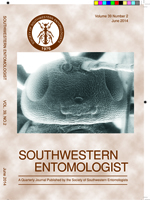Studies are lacking of entomofaunistic diversity studies in artificial ecosystems such as agroecosystems. It is estimated that in agroecosystems only 3% of the species behave as pests and 97% are auxiliary fauna. Transgenic cotton (Gossypium hirsutum L.) has a protein toxic against some lepidopterans; however, some studies mention that it harms other orders of insects. The purpose of this study was to identify the entomological diversity in transgenic cotton in the State of Coahuila, Mexico (25°49′25″N and 103°13′21″W). Entomological net, pitfall traps, and direct sampling were used each week. All adults collected were identified to species per family and order and deposited in the entomological collection of the Biological Sciences Faculty of Juárez University of Durango State. In total, 570 specimens were collected, of which 192 seemed to be distinct species belonging to 57 families in 10 orders. The order with the most insects was Hemiptera with 40% of the specimens, followed by Hymenoptera and Coleoptera, with 22 and 19%, respectively. The orders with the most species were Hymenoptera with 42% and Hemiptera with 30%. The families with the greatest numbers of insects were Cicadellidae with 140 and Curculionidae with 47. The families with the most species were Sphecidae with 15, Cicadellidae with 14 and Formicidae with 13. Only one insect was collected from each of 16 families.
How to translate text using browser tools
1 June 2014
Entomofaunistic Diversity in a Transgenic Cotton (Gossypium hirsutum L.) Agroecosystem in Coahuila, Mexico
C. Márquez-Hernández,
S. Santana,
V. Ávila,
J.L. García,
P. Preciado,
A. Moreno
ACCESS THE FULL ARTICLE

Southwestern Entomologist
Vol. 39 • No. 2
June 2014
Vol. 39 • No. 2
June 2014




